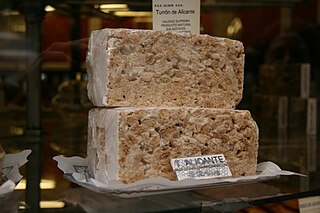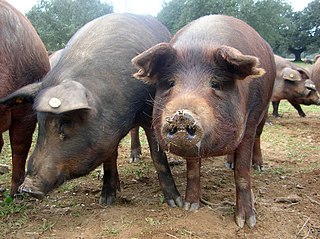
Spanish cuisine consists of the traditions and practices of Spanish cooking. It features considerable regional diversity, with significant differences among the traditions of each of Spain's regional cuisines.

Puerto Rican cuisine consists of the cooking style and traditional dishes original to Puerto Rico. It has been primarily a fusion influenced by the ancestors of the Puerto Rican people: the indigenous Taínos, Spanish Criollos and sub-Saharan African slaves. As a territory of the United States, the culinary scene of Puerto Rico has also been moderately influenced by American cuisine.

Turrón, torró or torrone is a Mediterranean nougat confection, typically made of honey, sugar, and egg white, with toasted almonds or other nuts, and usually shaped either into a rectangular tablet or a round cake. Turrón is usually eaten as a dessert food around Christmas in Spain and Italy. In Malta it is sold in street stalls as qubbajd during the parish patron saint feast of the various localities.

Biscotti are Italian almond biscuits originating in the city of Prato, Tuscany. They are twice-baked, oblong-shaped, dry, and crunchy. In Italy, they are known as cantucci, biscotti di Prato or biscotti etruschi and may be dipped in a drink, traditionally Vin Santo. Smaller biscotti may be known as biscottini or cantuccini. In Italian, the word biscotti encompasses all types of biscuits or cookies.

Torta is a culinary term that can, depending on the cuisine, refer to cakes, pies, flatbreads, sandwiches, or omelettes.

Castilleja de la Cuesta is a town and municipality in the province of Seville, in the autonomous community of Andalusia, Spain.
Andalusian cuisine is the regional cuisine of Andalusia, Spain. Notable dishes include gazpacho, fried fish, the jamones of Jabugo, Valle de los Pedroches and Trevélez, and the wines of Jerez, particularly sherry. Culinary influences come from the historic Christian, Muslim, and Jewish traditions of the region. The oldest known cookbook of Andalusian cuisine, Kitab al tabij fi-l-Maghrib wa-l-Andalus fi `asr al-Muwahhidin, li-mu'allif mayhul, dates from the 13th century.

Manchego cuisine refers to the typical dishes and ingredients in the cuisine of the Castilla–La Mancha region of Spain. These include pisto, gazpacho manchego, Manchego cheese, the white wine of La Mancha, and the red wine from Valdepeñas (DO).

Quiroga is a municipality in the province of Lugo, in the autonomous community of Galicia, Spain. It is the capital of the comarca of Quiroga. The south side of Quiroga is bordered by the river Sil.

Uruguayan cuisine is a fusion of cuisines from several European countries, especially of Mediterranean foods from Spain, Italy, Portugal and France. Other influences on the cuisine resulted from immigration from countries such as Germany and Scotland. Uruguayan gastronomy is a result of immigration, rather than local Amerindian cuisine, because of late-19th and early 20th century immigration waves of, mostly, Italians. Spanish influences are abundant: desserts like churros, flan, ensaimadas yoo (Catalan sweet bread), and alfajores were all brought from Spain. There are also various kinds of stews known as guisos or estofados, arroces, and fabada. All of the guisos and traditional pucheros (stews) are also of Spanish origin. Uruguayan preparations of fish, such as dried salt cod (bacalao), calamari, and octopus, originate from the Basque and Galician regions, and also Portugal. Due to its strong Italian tradition, all of the famous Italian pasta dishes are present in Uruguay including ravioli, lasagne, tortellini, fettuccine, and the traditional gnocchi. Although the pasta can be served with many sauces, there is one special sauce that was created by Uruguayans. Caruso sauce is a pasta sauce made from double cream, meat, onions, ham and mushrooms. It is very popular with sorrentinos and agnolotti. Additionally, there is Germanic influence in Uruguayan cuisine as well, particularly in sweet dishes. The pastries known as bizcochos are Germanic in origin: croissants, known as medialunas, are the most popular of these, and can be found in two varieties: butter- and lard-based. Also German in origin are the Berlinese known as bolas de fraile, and the rolls called piononos. The Biscochos were re-christened with local names given the difficult German phonology, and usually Uruguayanized by the addition of a dulce de leche filling. Even dishes like chucrut (sauerkraut) have also made it into mainstream Uruguayan dishes.

Extremadura, Spain is known for its different ways of preparing the Iberian pork and mutton. The main characteristics of the traditional Extremaduran cuisine are its simplicity, its lack of clutter and its low cost. It is also a cuisine reflecting a generous spirit, for many of its preparations used to be cooked in large pots to share with visitors, friends, and neighbors. The resulting dishes are eaten with local bread.

Arroz con gandules is a combination of rice, pigeon peas, and pork, cooked in the same pot with sofrito. This is Puerto Rico's national dish along with roasted pork.

Serra d'Espadà is a 51 km (32 mi) long mountain range in the Alt Palància, Alt Millars and Plana Baixa comarcas, in the Province of Castellón, Valencian Community, Spain. Its highest point is La Ràpita.

Serra Calderona, often referred to as La Calderona is a 49 km (30 mi) long mountain range in the Camp de Túria, Horta Nord and Alt Palància comarcas of the Valencian Community, between the provinces of Castelló and Valencia Spain.

Juan Luis Galiardo Comes was a Spanish television, theater and film actor.

Acesur is a leading company within the olive oil sector in Spain, with 100% Spanish capital share and among the top five in the international market. Its activities revolve around the production, refining, bottling, marketing and exportation of olive and vegetable oil as well as olives, vinegars, sauces, mayonnaises and condiments. It owns brands known as "La Española", "Coosur", and "Al Amir". Acesur has received prizes such as the Aster award.

The cuisine of Veracruz is the regional cooking of Veracruz, a Mexican state along the Gulf of Mexico. Its cooking is characterized by three main influences—indigenous, Spanish, and Afro-Cuban—per its history, which included the arrival of the Spanish and of enslaved people from Africa and the Caribbean. These influences have contributed many ingredients to the cooking including native vanilla, corn and seafood, along with rice, spices and tubers. How much the three mix depending on the area of the state, with some areas more heavily favoring one or another. The state has worked to promote its cuisine both in Mexico and abroad as part of its tourism industry.

Spanish object pronouns are Spanish personal pronouns that take the function of the object in the sentence. Object pronouns may be both clitic and non-clitic, with non-clitic forms carrying greater emphasis. When used as clitics, object pronouns are generally proclitic, i.e. they appear before the verb of which they are the object; enclitic pronouns appear with positive imperatives, infinitives, and gerunds. Non-clitic forms, by contrast, can appear anywhere in the sentence but can only rarely be used without their clitic counterparts. When used together, clitic pronouns cluster in specific orders based primarily on person, and clitic doubling is often found as well. In many dialects in Central Spain, including that of Madrid, there exists the phenomenon of leísmo, which is using the indirect object pronoun le as the direct object pronoun where most other dialects would use lo (masculine) or la (feminine).

















